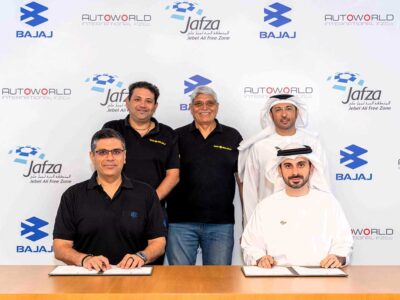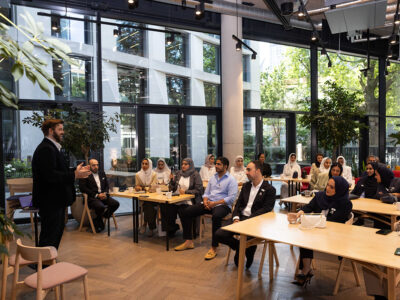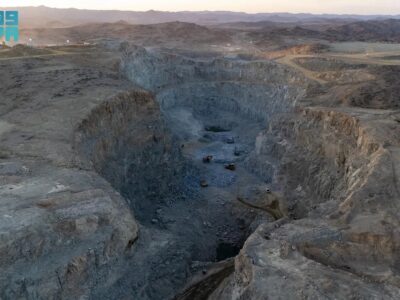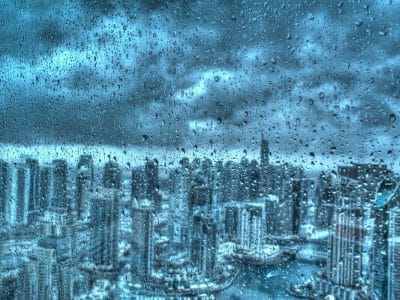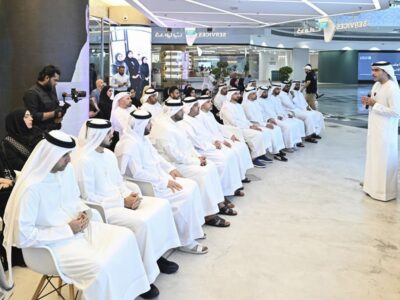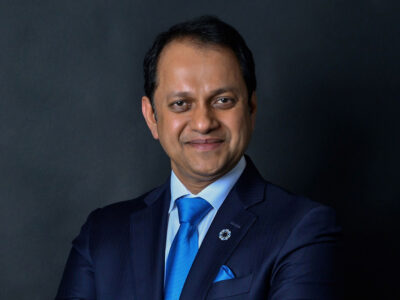As the QE2 made its final journey to its new home in Dubai, more than 80 television crew worked round-the-clock to bring this historic moment to our TV screens. In an exclusive interview with Vijaya Cherian, production firm Widescreen Ltd shares the challenges of covering the event live and documenting it for posterity.
In December 2008, we witnessed a historic moment when the last of the world’s great Transatlantic liners, the Queen Elizabeth 2 (QE2) sailed the seas for the last time before coming to its rest on the coast of Dubai.
Even as thousands of residents stood on the shore to welcome the cruiseliner and the Royal Navy and Dubai’s ruler Sheikh Mohammed bin Rashid Al Maktoum’s private yacht, My Dubai, escorted the ship to her new home, more than 80 people including production crew, satellite technicians and other engineers worked round-the-clock to produce and broadcast the event live to TV screens worldwide.
UK-based production company Widescreen Ltd worked closely with Dubai-based event management company HQ Creative on the production of The Arrival of the QE2.
“Basically, our brief was to provide a worldwide TV feed to all the broadcasters in the world, and give this historical journey a unique perspective,” claims Widescreen Ltd’s Jason Shepherd, who directed The Arrival of the QE2.
“Our personal goal was to make it even better than the BBC’s footage of the QE2 taking off from the UK’s shores. I believe we achieved this; I know the pictures we supplied have been very well received everywhere.”
Along with this world feed, Widescreen was also supposed to produce continuous news reports about the journey. This was done in partnership with On-line Broadcast, which handled the news feeds to the broadcasters while Widescreen took over the visual and technical aspects of the shoot.
Planning for the production of the event began four weeks before the arrival of the QE2.
Widescreen, which is well known for producing big events for TV, was subcontracted by HQ Creative to undertake the production aspect. It was decided that the project would be shot on the latest HD format.
“We shot to feature-film quality and had a mix of Sony 1500 CCU-controlled and Sony F900R cameras. We also used a lot of special lenses for this shoot including the new Canon 110:1 HD lenses, which are very powerful and also very rare to come by. We were getting very usable pictures of the QE2 when she was more than five miles away. They have a superb image stabilisation system that is second to none and this proved very useful on the remote camera sites,” explains Shepherd.
As time was short, preparations for the production had to begin quickly, explains Widescreen. “We were busy producing the World Music Awards (WMA) and were about to fly to Monte Carlo for the shoot when HQ contacted us. So before we went there, we hopped on a plane to Dubai five days before the WMA’s production went live. We did the recce by helicopter to see where we had to put the cameras and then did a land recce to see how to achieve this. When we did the recce, we sort of knew where to place the cameras from past experience.”
Three years prior to this event, Widescreen had worked on the launch of P&O’s Arcadia in Southampton, and this experience helped Widescreen understand some of the challenges of filming ships, says Shepherd.
“Paul Weber from HQ Creative did all the negotiations and secured permissions for camera positions. HQ provided the logistical team and rigging crew for all the scaffold structures,” explains Shepherd.
Based on the recce and the need to get some unique perspectives of the journey, cameras needed to be placed at different locations in Dubai including My World, in Maritime City and some remote areas close to The Palm.
Besides this, different kinds of cameras were also placed in helicopters, the Royal Navy, My Dubai as well as in the latest aircraft from Emirates Airlines.A huge camera platform was built at My World. This platform was built on sand on top of one of the islands that was closest to the My World break wall. The scaffolding tower was nearly four metres high. Cameras were also placed on the Port break wall.
“The only way the scaffolders, camera technicians and RF camera engineers could get to these remote sites was by boat,” explains Shepherd.
“In some areas, the crew even had to wade through water as they could not get the boats close enough to the shore.”
Due to the positioning of the cameras and the fact that the team was broadcasting live, this project also required a number of RF cameras. The team had three very remote sites with cameras sending live pictures to the control area.
Along with this, a Cineflex HD camera was mounted on a helicopter with live links. All cameras had two-way communications with full CCU control for picture/colour balancing.
“Broadcast RF supplied the technicians and the RF equipment. The helicopter Link was a Digital Diversity system by Gigawave (I think) and it provided very stable pictures even at very low level when line-of-sight transmission was blocked. This system had been used for the Atlantis shoot the previous week although I believe different types of antennas were shipped in for our shoot due to the long range we needed for the helicopter pictures. The other RF equipment was shipped in by us from Broadcast RF. I had asked for all the cameras to be controlled from the production control area so the transmitted pictures would look good on our live transmission. This equipment included RF relay stations on top of buildings in Maritime City,” explains Shepherd.
Shooting out of Maritime City again posed a huge challenge as the team needed to get to the top of one the buildings that was still being constructed, says Shepherd. However, as Nakheel was the client, permissions were granted quickly and a scaffolding tower was built on top of this building.
“This was approximately two metres high, which gave us a 270 degree angle shot of the QE2 – from out at sea – all the way into the port for the fireworks display. We built this tower so that the master shot would be clear of cranes and other buildings,” explains Shepherd.
“Maritime City was extremely helpful in the co-ordination of this camera and they supplied the scaffolding and engineers to ensure that our crew would be safe at the top of the building.”
The shoot itself and the compositions were unique, claims Shepherd. To achieve this, one the newest aircraft in the World, the Emirates Airbus A380 – a two-deck plane – did a welcome fly-past to the QE2 just beside My World.
Two mini Sony HD cameras were mounted in the cockpit of the A380 to give a wide shot of the cockpit with the pilots. Another camera was mounted on the window to give the pilot’s perspective of the QE2 as they did the fly-past providing yet another unique shot of the QE2.
“We managed to get an F900R camera onto the Royal Navy’s HMS Lancaster. This ship was the QE2’s escort for her handover to Nakheel. This camera got great shots of the Royal Navy’s final ‘goodbye salute’ to the QE2,” explains Shepherd.
“The helicopter also got great shots of this as we were allowed to fly in between the two ships while the salute took place.”
An F900R camera was also mounted on the coastguard’s boat to provide low-level pictures of the QE2 while a high-speed chase boat brought the crew, who were located at remote sites back to the QE2 in time for the rest of the shoot.
“These teams were back on the QE2 when the harbour pilot jumped on board the ship. Timing was critical to make sure we had the crews in the right place at the right time. This required a highspeed boat to ensure these crews got on the QE2. We had a camera crew on My Dubai as well. My Dubai was leading the flotilla and this gave us a stable front angle of the QE2 and sea-level shots of the Airbus A380 fly-past,” explains Shepherd.
This production was especially successful because the camera positions and angles were accurate and not just based on a rough recce, explains Shepherd. The team was given the route of the QE2 by Cunard and Nakheel and HQ plotted this onto a map. This information was then transferred onto satellite photos and from here, onto the PC using Lightwave 3D.
“We don’t work on conjecture anymore. Computers are a lot more accurate. Using the longitude and latitude, we were able to gauge within the 3D software what the shot would be like. You can input camera angles, heights and distances and build a virtual model of the ship in the software. We did not have time to build a life-like model but it gave us an idea of the shots we would need. It helped me be sure that the camera positions I had planned around Port Rashid and My World would work. I also plotted in the A380 fly-past into the software to estimate what the shot would be like. Of course, with a shot like this, you also need to trust the helicopter cameraman and pilots of both aircraft,” says Shepherd.Approximately 180 people worked at the site including HQ Creative, online broadcast, news agencies, satellite technicians, rigging crew, drivers, boat crew, Lighting and events teams.
Of these, 80 people were directly involved in just the TV production and broadcast while others provided logistical support. Widescreen brought 50 technical people from the UK while about 30 others were sourced locally including helicopter technicians, riggers and the HQ Creative team.
3.5 tonnes of equipment were air freighted to Dubai just for this shoot, and the kit was insured for US $10 million,” says Shepherd.
He also claims that the event was a huge hit as Sky News streamed the whole event live on the Web as did the BBC and ITN. Sky, ITN, CNN, Reuters, BBC as well as several others apart from showing it on their respective channels.
“We provided live feeds to the world for about six hours. The BBC, Sky, CNN, ABC, Reuters etc were all taking us live internationally plus there were simultaneous live news reports going out from the dockside in Dubai to the news agencies.”
Providing feeds to so many different platforms was possible with the help of an HD matrix, explains Shepherd. “We used a very powerful HD matrix to provide several different feeds to the satellite trucks in many different formats and TV standards to multiple sources simultaneously if required. We employed two EVS edit stations and used the EVS data transfer protocol onto a shared five terabytes fibre storage. This allowed us to share the footage with two HD/SD edit suites allowing us to fine cut news films and supply a fine edit of the day’s events within minutes of the footage coming in,” explains Shepherd.
In the meantime, Widescreen is also undertaking a full-blown HD edit for Nakheel on an AVID DS Nitrus in uncompressed mode. The footage will then be laid off to HDCam SR to retain quality.
Almost 11 different companies were subcontracted to ensure that the QE2’s journey to its new home was well documented for posterity be it for live broadcast, news reports, a potential future documentary or even just for promotional material for Nakheel.
While not much is known about what will become of the QE2, there are rumours that Dubai will restore the oceanliner to its former glory. For now, however, suffice to say that Dubai pulled out all stops to ensure that the final journey of the QE2 from the UK to the emirate was well documented and produced to international standards.
“We were capturing a piece of history here with the QE2 moving from Southampton to her new home in Dubai, and I believe we did it justice,” adds Shepherd.
• Widescreen Ltd supplied all the production team, UK camera and sound crew, some F900R cameras plus Avid DS Nitrus HD and Symphony Nitrus HD editing solutions in the UK.
• TimeLine Broadcast provided the production gallery (vision mixer, standards convertors, HD matrix), on site FCP HD and EVS edit system, sound gallery plus as well as video engineering crew and two editors.
• Presteigne Charter provided Sony HDW1500 cameras with CCUs and fibre cables as well as Canon 110:1 and Canon 86:1 lenses. They provided much of the studio camera accessories and glue equipment.
• Atlas Television provided the Jimmy Jib, Cineflex, 2 HD camcorders, Steadicam and 2x Camera crews.
• Broadcast RF provided Video RF channels for Helecopter and remote camera sites.
• Mike Weaver Communications supplied the radio communications for talkback including remote site talkback.
• Online Broadcast provided one news edit suite, booking the satellite truck and satellite space. It handled press releases and news organisations.
• EFM provided shipping and logistics.
• Peter Davis provided HD cameras and crew.
• Air Dubai supplied the helicopter and pilot.
